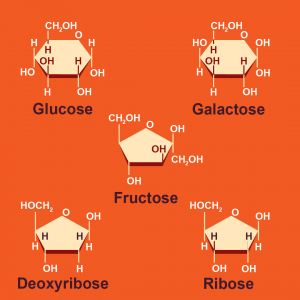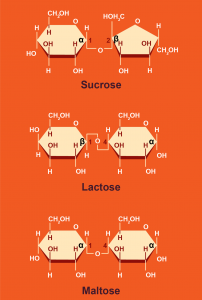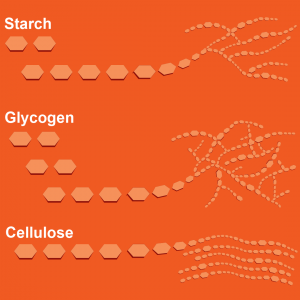Carbohydrates
Carbohydrates are a biological polymer made of monomers called monosaccharides. Monosaccharides are sometimes referred to as “simple sugars” because they are the building block for large, complex carbohydrates or sugars. Monosaccharides containing six carbons, or hexose sugars, include glucose, fructose, and galactose. The hexose sugars are the main fuels of cells, especially glucose. Monosaccharides containing five carbons, or pentose sugars, include ribose and deoxyribose. The pentose sugars are important components of nucleic acids such as deoxyribonucleic acid (DNA) and ribonucleic acid (RNA).

Carbohydrates are named based on the length of the polymer chain. Monosaccharides are the simplest carbohydrate and contain carbon, hydrogen, and oxygen in a ratio of 1:2:1. When two monosaccharides are covalently linked by dehydration synthesis, a water molecule is generated, and the resulting disaccharide no longer contains a C:H:O ratio of 1:2:1. The covalent bonds that link monosaccharides to one another and to other molecules is known as a glycosidic bond.
Three biologically important disaccharides are sucrose, maltose, and lactose. Sucrose is a polymer containing one glucose and one fructose sugar. Maltose is a polymer containing two glucose sugars. Lactose is a polymer containing one glucose and one galactose sugar.

Sucrose is simple table sugar and sweetens food. Maltose also lends sweetness to foods and beverages, such as beer. Lactose is a sugar found in dairy products such as milk and cheese.
Carbohydrates that consist of hundreds or thousands of monosaccharides are called polysaccharides. Polysaccharides play vital roles inside and outside of cells. Three biologically important polysaccharides include glycogen, starch, and cellulose. All three of the following polysaccharides consist only of glucose monomers linked by glycosidic bonds. However, the arrangement of glucose monomers differs between the polymers.
Glycogen consists of branched chains of glucose monomers linked by glycosidic bonds. Glycogen is only made in animal cells, such as human liver cells or hepatocytes and is the storage polysaccharide of animal cells. When human cells need energy, cellular enzymes hydrolyze the glycosidic bond between a glucose monomer and the rest of the chain to release glucose for energy processing reactions.
Starch is a long linear chain of glucose monomers linked by glycosidic bonds. The glycosidic bonds in starch and glycogen are identical but, unlike glycogen, starch is unbranched. Starch is synthesized by plant cells to store chemical potential energy. Therefore, starch is known as the storage polysaccharide of plant cells. When humans eat plants, the starch in those cells can be broken down by our digestive system to release glucose to our cells for energy processing reactions.
Cellulose, like starch, is a long linear chain of glucose monomers linked by glycosidic bonds. However, the glycosidic bond in cellulose is different from the glycosidic bond in starch and glycogen. Cellulose forms rigid fibres that support the structure of plant cells in a structure known as the plant cell wall. As a result, cellulose is known as the structural polysaccharide of plant cells and cannot be made by human cells. Human cells do not have the enzymes to hydrolyze the glycosidic bond in cellulose. Therefore, when we eat cellulose-rich plant foods, these materials travel nearly intact through our digestive systems and act as fibre to keep bowel movements regular.


